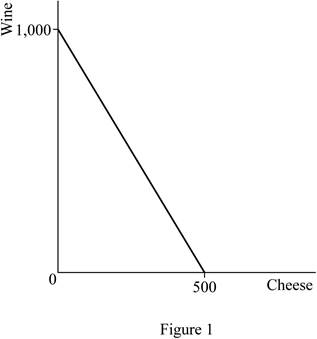
The budget constraint of the consumer.
Explanation of Solution
The budget constraint is the constraint which is due to the budget of the individual. The human wants and needs are unlimited and when the budget of the individual is not unlimited, it will lead to the constraint of needs and this constraint raised due to the limited budget is known as the budget constraint of the individual. Thus, a budget constraint will represent all the possible combinations of two commodities that an individual can consume at the given market prices and with all his income in hand.
Here, the income of the person is given as $3,000, the
Thus, when she spends all her income on cheese, she can buy 500 pounds of cheese. When she spends all her income on the wine, the quantity can be calculated by replacing the price of cheese with that of wine as follows:
Thus, when she spends all her income on wine, she can receive 1,000 glasses of wine.
The budget constraint represents all the combinations of these two goods ranging between 500 pounds of cheese and no wine to no cheese and 1,000 glasses of wine. The vertical axis represents wine and the horizontal represents cheese on our diagram. The 500 pounds of cheese and no wine point represent the horizontal intercept and the no cheese and 1,000 glasses of wine represent the vertical intercept. The budget constraint can be drawn as follows:

The slope of the budget constraint is the rise over the run. It can be calculated by dividing the negative vertical intercept (represented by –b) by the horizontal intercept (represented by a) as follows:
Thus, the slope of the budget constraint is -2.
Concept introduction:
Budget constraint: It represents all the combinations of two goods that the consumer can consume with the given price level and the income in the hands of the individual.
Want to see more full solutions like this?
Chapter 21 Solutions
Principles of Economics
- Critically analyse the five (5) characteristics of Ubuntu and provide examples of how they apply to the National Health Insurance (NHI) in South Africa.arrow_forwardCritically analyse the five (5) characteristics of Ubuntu and provide examples of how they apply to the National Health Insurance (NHI) in South Africa.arrow_forwardOutline the nine (9) consumer rights as specified in the Consumer Rights Act in South Africa.arrow_forward
- In what ways could you show the attractiveness of Philippines in the form of videos/campaigns to foreign investors? Cite 10 examples.arrow_forwardExplain the following terms and provide an example for each term: • Corruption • Fraud • Briberyarrow_forwardIn what ways could you show the attractiveness of a country in the form of videos/campaigns?arrow_forward
 Principles of MicroeconomicsEconomicsISBN:9781305156050Author:N. Gregory MankiwPublisher:Cengage Learning
Principles of MicroeconomicsEconomicsISBN:9781305156050Author:N. Gregory MankiwPublisher:Cengage Learning Principles of Microeconomics (MindTap Course List)EconomicsISBN:9781305971493Author:N. Gregory MankiwPublisher:Cengage Learning
Principles of Microeconomics (MindTap Course List)EconomicsISBN:9781305971493Author:N. Gregory MankiwPublisher:Cengage Learning

 Economics (MindTap Course List)EconomicsISBN:9781337617383Author:Roger A. ArnoldPublisher:Cengage Learning
Economics (MindTap Course List)EconomicsISBN:9781337617383Author:Roger A. ArnoldPublisher:Cengage Learning





